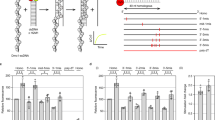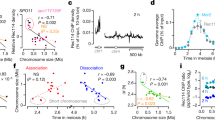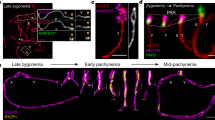Abstract
During the first meiotic division, homologous chromosomes (homologs) have to separate to opposite poles of the cell to ensure the right complement in the progeny. Homologous recombination provides a mechanism for a genome-wide homology search and physical linkage among the homologs before their orderly segregation. Rad51 and Dmc1 recombinases are the major players in these processes. Disruption of meiosis-specific HOP2 or MND1 genes leads to severe defects in homologous synapsis and an early-stage recombination failure resulting in sterility. Here we show that mouse Hop2 can efficiently form D-loops, the first recombination intermediates, but this activity is abrogated upon association with Mnd1. Furthermore, the Hop2–Mnd1 heterodimer physically interacts with Rad51 and Dmc1 recombinases and stimulates their activity up to 35-fold. Our data reveal an interplay among Hop2, Mnd1 and Rad51 and Dmc1 in the formation of the first recombination intermediates during meiosis.
This is a preview of subscription content, access via your institution
Access options
Subscribe to this journal
Receive 12 print issues and online access
$209.00 per year
only $17.42 per issue
Buy this article
- Purchase on SpringerLink
- Instant access to full article PDF
Prices may be subject to local taxes which are calculated during checkout




Similar content being viewed by others
References
Zierhut, C., Berlinger, M., Rupp, C., Shinohara, A. & Klein, F. Mnd1 is required for meiotic interhomolog repair. Curr. Biol. 14, 752–762 (2004).
Saito, T.T., Tougan, T., Kasama, T., Okuzaki, D. & Nojima, H. Mcp7, a meiosis-specific coiled-coil protein of fission yeast, associates with Meu13 and is required for meiotic recombination. Nucleic Acids Res. 32, 3325–3339 (2004).
Enomoto, R. et al. Positive Role of the Mammalian TBPIP/HOP2 protein in DMC1-mediated homologous pairing. J Biol. Chem. 279, 35263–35272 (2004).
Chen, Y.K. et al. Heterodimeric complexes of Hop2 and Mnd1 function with Dmc1 to promote meiotic homolog juxtaposition and strand assimilation. Proc. Natl. Acad. Sci. USA 101, 10572–10577 (2004).
Tsubouchi, H. & Roeder, G.S. The importance of genetic recombination for fidelity of chromosome pairing in meiosis. Dev. Cell 5, 915–925 (2003).
Schommer, C., Beven, A., Lawrenson, T., Shaw, P. & Sablowski, R. AHP2 is required for bivalent formation and for segregation of homologous chromosomes in Arabidopsis meiosis. Plant J. 36, 1–11 (2003).
Petukhova, G.V., Romanienko, P.J. & Camerini-Otero, R.D. The Hop2 protein has a direct role in promoting interhomolog interactions during mouse meiosis. Dev. Cell 5, 927–936 (2003).
Tsubouchi, H. & Roeder, G.S. The Mnd1 protein forms a complex with hop2 to promote homologous chromosome pairing and meiotic double-strand break repair. Mol. Cell. Biol. 22, 3078–3088 (2002).
Gerton, J.L. & DeRisi, J.L. Mnd1p: an evolutionarily conserved protein required for meiotic recombination. Proc. Natl. Acad. Sci. USA 99, 6895–6900 (2002).
Rabitsch, K.P. et al. A screen for genes required for meiosis and spore formation based on whole-genome expression. Curr. Biol. 11, 1001–1009 (2001).
Nabeshima, K., Kakihara, Y., Hiraoka, Y. & Nojima, H. A novel meiosis-specific protein of fission yeast, Meu13p, promotes homologous pairing independently of homologous recombination. EMBO J. 20, 3871–3881 (2001).
Leu, J.Y., Chua, P.R. & Roeder, G.S. The meiosis-specific Hop2 protein of S. cerevisiae ensures synapsis between homologous chromosomes. Cell 94, 375–386 (1998).
Cox, M.M. The bacterial RecA protein as a motor protein. Annu. Rev. Microbiol. 57, 551–577 (2003).
Noirot, P., Gupta, R.C., Radding, C.M. & Kolodner, R.D. Hallmarks of homology recognition by RecA-like recombinases are exhibited by the unrelated Escherichia coli RecT protein. EMBO J. 22, 324–334 (2003).
Sung, P. & Robberson, D.L. DNA strand exchange mediated by a RAD51-ssDNA nucleoprotein filament with polarity opposite to that of RecA. Cell 82, 453–461 (1995).
Sehorn, M.G., Sigurdsson, S., Bussen, W., Unger, V.M. & Sung, P. Human meiotic recombinase Dmc1 promotes ATP-dependent homologous DNA strand exchange. Nature 429, 433–437 (2004).
Gasior, S.L. et al. Assembly of RecA-like recombinases: distinct roles for mediator proteins in mitosis and meiosis. Proc. Natl. Acad. Sci. USA 98, 8411–8418 (2001).
Conway, A.B. et al. Crystal structure of a Rad51 filament. Nat. Struct. Mol. Biol. 11, 791–796 (2004).
Bugreev, D.V. & Mazin, A.V. Ca2+ activates human homologous recombination protein Rad51 by modulating its ATPase activity. Proc. Natl. Acad. Sci. USA 101, 9988–9993 (2004).
Shinohara, A. & Shinohara, M. Roles of RecA homologues Rad51 and Dmc1 during meiotic recombination. Cytogenet. Genome Res. 107, 201–207 (2004).
Lio, Y.C., Mazin, A.V., Kowalczykowski, S.C. & Chen, D.J. Complex formation by the human Rad51B and Rad51C DNA repair proteins and their activities in vitro. J. Biol. Chem. 278, 2469–2478 (2003).
Zickler, D. & Kleckner, N. Meiotic chromosomes: integrating structure and function. Annu. Rev. Genet. 33, 603–754 (1999).
Hayase, A. et al. A protein complex containing Mei5 and Sae3 promotes the assembly of the meiosis-specific RecA homolog Dmc1. Cell 119, 927–940 (2004).
Tsubouchi, H. & Roeder, G.S. The budding yeast mei5 and sae3 proteins act together with dmc1 during meiotic recombination. Genetics 168, 1219–1230 (2004).
Rijkers, T. et al. Targeted inactivation of mouse RAD52 reduces homologous recombination but not resistance to ionizing radiation. Mol. Cell. Biol. 18, 6423–6429 (1998).
Essers, J. et al. Disruption of mouse RAD54 reduces ionizing radiation resistance and homologous recombination. Cell 89, 195–204 (1997).
Krogh, B.O. & Symington, L.S. Recombination proteins in yeast. Annu. Rev. Genet. 38, 233–271 (2004).
Sung, P., Krejci, L., Van Komen, S. & Sehorn, M.G. Rad51 recombinase and recombination mediators. J. Biol. Chem. 278, 42729–42732 (2003).
Baumann, P., Benson, F.E., Hajibagheri, N. & West, S.C. Purification of human Rad51 protein by selective spermidine precipitation. Mutat. Res. 384, 65–72 (1997).
Masson, J.Y. et al. The meiosis-specific recombinase hDmc1 forms ring structures and interacts with hRad51. EMBO J. 18, 6552–6560 (1999).
Sigurdsson, S., Trujillo, K., Song, B., Stratton, S. & Sung, P. Basis for avid homologous DNA strand exchange by human Rad51 and RPA. J. Biol. Chem. 276, 8798–8806 (2001).
Hsieh, P., Camerini-Otero, C.S. & Camerini-Otero, R.D. The synapsis event in the homologous pairing of DNAs: RecA recognizes and pairs less than one helical repeat of DNA. Proc. Natl. Acad. Sci. USA 89, 6492–6496 (1992).
Borde, V. et al. Association of Mre11p with double-strand break sites during yeast meiosis. Mol. Cell 13, 389–401 (2004).
Acknowledgements
J.Y.M. is a Canadian Institutes of Health Research new investigator and this work is supported by grants from the National Cancer Institute of Canada and the National Science and Engineering Research Council of Canada. We thank O. Voloshin for the RecA protein, P. Romanienko for the Hop2 cDNA, and P. Hsieh, M. Lichten and O. Voloshin for valuable comments on the manuscript.
Author information
Authors and Affiliations
Corresponding author
Ethics declarations
Competing interests
The authors declare no competing financial interests.
Supplementary information
Supplementary Fig. 1
DNA binding of Hop2–Mnd1 complex. (PDF 280 kb)
Supplementary Fig. 2
Single-strand annealing activity is not sufficient for D-loop formation. (PDF 1038 kb)
Supplementary Fig. 3
Hop2 does not denature dsDNA. (PDF 1371 kb)
Rights and permissions
About this article
Cite this article
Petukhova, G., Pezza, R., Vanevski, F. et al. The Hop2 and Mnd1 proteins act in concert with Rad51 and Dmc1 in meiotic recombination. Nat Struct Mol Biol 12, 449–453 (2005). https://doi.org/10.1038/nsmb923
Received:
Accepted:
Published:
Issue Date:
DOI: https://doi.org/10.1038/nsmb923
This article is cited by
-
Differential expression of meiosis and homologous recombination-related genes in the life cycle of Trypanosoma cruzi
Parasitology Research (2023)
-
Repair of DNA double-strand breaks in plant meiosis: role of eukaryotic RecA recombinases and their modulators
Plant Reproduction (2023)
-
Meiotic nuclear divisions 1 promotes proliferation and metastasis in hepatocellular carcinoma and is a potential diagnostic and therapeutic target gene
Medical Oncology (2022)
-
The Arabidopsis HOP2 gene has a role in preventing illegitimate connections between nonhomologous chromosome regions
Chromosome Research (2022)
-
Immediate visualization of recombination events and chromosome segregation defects in fission yeast meiosis
Chromosoma (2019)



